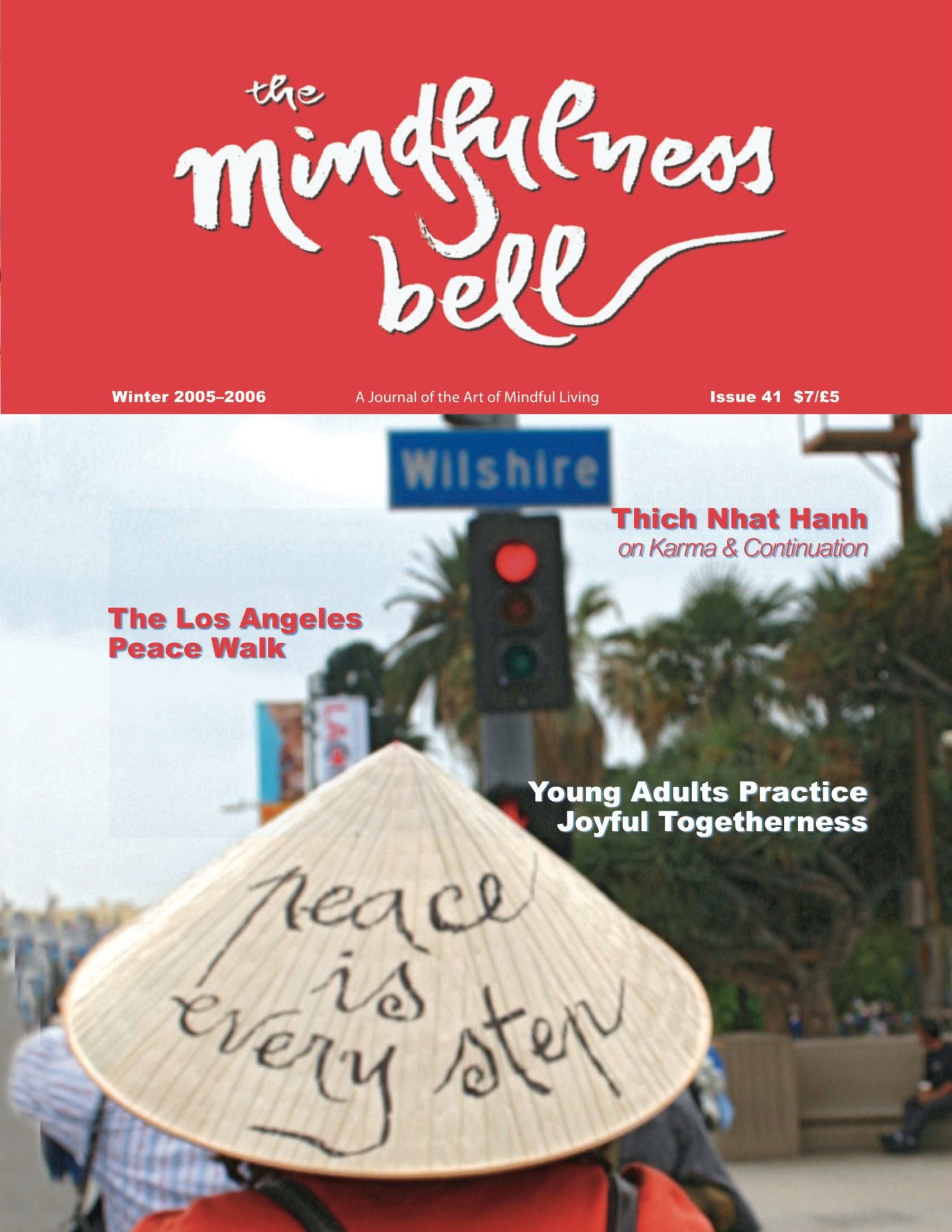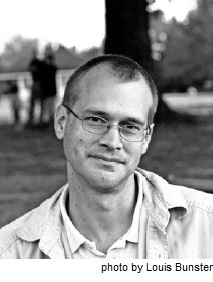
By Steve Black
“In the Ultimate I dwell,” Thay says. And turning to the child holding his right hand, he says, “Do you know what the Ultimate is?”
Silence. The child looks at Thay. His head is level with Thay’s thigh. He says nothing.
Thay gently repeats the question: “Do you know what the Ultimate is?”
“No,” the child says. “Neither do I,” Thay replies.

By Steve Black
“In the Ultimate I dwell,” Thay says. And turning to the child holding his right hand, he says, “Do you know what the Ultimate is?”
Silence. The child looks at Thay. His head is level with Thay’s thigh. He says nothing.
Thay gently repeats the question: “Do you know what the Ultimate is?”
“No,” the child says. “Neither do I,” Thay replies.
They begin walking, Thay and the two children on his left and right.
A few steps later they stop again.
“If you don’t know what the Ultimate is, I’ll tell you tomorrow,” Thay says. “It’s a kind of plant. It’s a kind of flower.” He grins.
And with that we begin walking along the front of the meditation hall, which has been newly built in the Mississippi hill country, about four miles from Batesville. It is Tuesday, October 11, Thay’s seventy-ninth Continuation Day and the first morning of his visit to Magnolia Village. Over 200 of us are gathered here this morning. Tomorrow, on the Mindfulness Day, that number will increase more than 300, and more than forty people will receive the Five Mindfulness Trainings. On both days, roughly half the participants are Vietnamese and the other half are Westerners.
We walk through the chilly morning fog, around the long meditation hall, and across a wide field lined on either side with the tents of those of us who are staying at the center during Thay’s four-day visit here. There are no dormitories. In fact, the only structures here are the meditation hall, a one-story house where Thay and the monks are staying, a mobile home that is being used to house the nuns, and a hand-hewn corn crib that was built in the nineteenth century and stands as a witness to the land’s former manifestation as a cattle farm.
This land, 118 acres in all, is a gift from the North Mississippi Vietnamese community. Inspired by Thay’s visit to Memphis for Peace Walk 2002, they began to look for property suitable for a practice center. A year later, in November 2003, they had located this property. Now, twenty-three months later, the sale of the land has closed, and the meditation hall has been built, along with a beautifully landscaped pond with a bridge leading to a Kwan Yin statue on a small island.
Learning the Landscape
The history of this land on which we are walking is at once rich in joy and saturated with suffering. On land that was worked by slaves forced into labor, on land in a state that, through lynchings and countless acts of brutality and small, daily humiliations, has become the emblem of the racism that has darkened our entire country’s history for so many centuries, on land that has known the joys of generations of farm children at play, we are now enjoying these precious four days with Thay and the monastics and friends who have gathered here from Arizona, Colorado, Georgia, Illinois, Kansas, Louisiana, Michigan, Missouri, North Carolina, South Carolina, Tennessee, and Texas.
The grass is damp from heavy dew and by the time we have reached the middle of the field, my shoes are soaked through. They will remain uncomfortably wet until the sun emerges in the early afternoon and begins to dry them. But there is a joy and solidarity in this dampness. All around me I see people with their shoes soaked, their pants wet up to their calves, brown grass blades stuck on their heels and pants legs. We are all walking together.
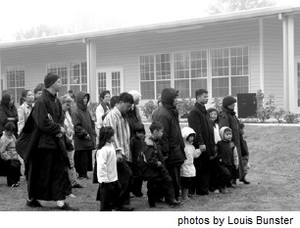
At the end of the field, we walk through a gate and onto a gravel lane, down into a ravine and out again, stepping into a wide pasture. We are walking slowly, learning this new landscape as we go: its dry creek beds; its unexpected patches of late blooming swamp sunflowers, blue wild ageratums, and purple beauty berries; its stands of persimmon, oak, cedar, pines, sassafras, and sweetgum trees.
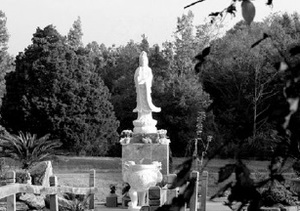
We walk for a long time, stopping finally along the edge of the pasture, and Thay sits on the ground. We all ease ourselves onto the wet grass, taking a moment to find a position that will ensure the least amount of dampness. Thay shows the children how to make the “five mountains” with their hands and then Sister Chan Khong begins singing. Thay guides us in the singing as well, making us repeat verses when we lose the melody or sing off key. At one point, during “I Take Refuge in the Buddha” he stops us and, reminding us of our southern roots, says, half-scoldingly, “This is country music.” It’s true, I realize, when Thay begins singing again; here we are in Mississippi, singing about taking refuge in the Buddha to a traditional country melody.
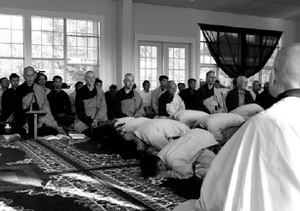
Blessings
Later that morning, in the meditation hall, Thay formally accepts the donation of the practice center. He has promised us that, two or three times a year, monastics will come to Magnolia Village to lead retreats, and he says that if the Sangha practice in the Mid-South area becomes strong, he will send a group of resident monastics in a few years. As part of the Acceptance Ceremony, the monks offer a chant, and then Thay stands and, lifting a glass of water and a long-stemmed rose, begins flinging droplets onto the fruit and flower offerings on the altar. He steps up onto the altar and sprays water onto the Buddha statue made out of beautiful white Vietnamese marble. Stepping down, Thay walks along the side of the hall, flinging water onto the walls and dropping it onto the heads of the people sitting along the edge of the room. And once Thay has circled the room, he begins to walk up and down the rows of people sitting on cushions, dropping water onto our heads. Thay walks up behind me and I can’t hear his feet approaching. Suddenly there is the sound of rose petals rustling above me and when the drops fall on the crown of my head, I feel as if a weight has landed on me. I bow my head slightly and Thay steps quietly forward.
Sitting there, I bow in gratitude to Thay for coming to Magnolia Village. I bow in gratitude to the opportunity to practice with so many friends on the path. I bow in gratitude for this opportunity to dwell in the Ultimate in North Mississippi.
Whatever the Ultimate might be.
Steve Black, Compassionate Continuation of the Heart, and his wife, Virginia, Peaceful Mountain of the Heart, live and practice in Statesboro, Georgia.

